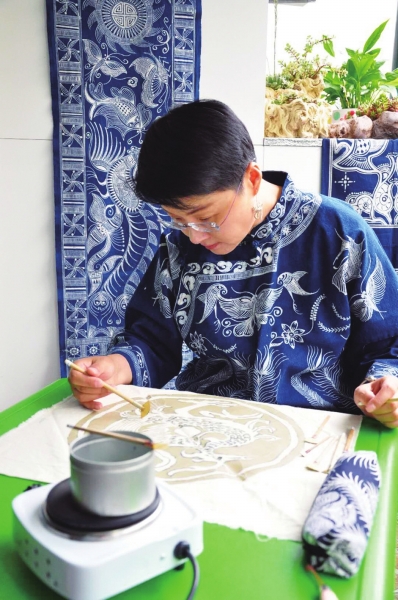Intangible Cultural Heritage "Enter" Daily Life

By Lu Xuejiao
What can a piece of wax-dyed cloth make? Yang Ning loves traditional folk art since childhood. However, as a senior management member of foreign-funded company, she quit her high-salary career and devoted herself to batik. Now Yang Ning has a new identity. She managed to apply for the traditional batik of the intangible cultural heritage of Hongkou. She not only masters the batik, but also creates new styles with her hands.
In the window of Guangzhong Road Sub-district Cultural Activity Center, Yang Ning's batik works are fully displayed. She has devoted a lot of effort to every work, from base maps to finished products, and from plain clothes to batik derivatives. Batik, a skill of Miao nationality, is time-consuming and laborious, while Yang enjoys it. She was wearing a dress named “birds paying homage to the phoenix”, which took three months to complete it. Yang calls it a war dress that was painted with phoenix and butterflies in love with flowers. She spent a lot of clever thinking to conceive even if it was just a little design of clasp, so that the batik garment could look fashionable.
It is learned that the inheritor Yang has traveled through 30 countries in the world and has felt diversified cultures. She generally realized that in order to maintain the long-term vitality of traditional skills, it is necessary to make intangible cultural heritage keep pace with the times. Only in this way can it be passed down and be accepted and liked by more young people. Therefore, she began to integrate more modern design into batik works, including drawing red elements on batik cloth, making jewelry with wax-dyed cloth. In addition, she combined batik elements with leather goods to make a series of cultural and creative works.
At present, Yang carried out in-depth cooperation with the sub-districts in Hongkou through a variety of lectures and training courses, so that traditional batik technique can be spread to more places. In order to make batik "live", she also launched some works with novel patterns and simple procedures to let people at different ages feel them. In the future, Yang will continue to explore more ways to revive intangible cultural heritage and create more batik cultural products on the basis of respecting batik handicraft.